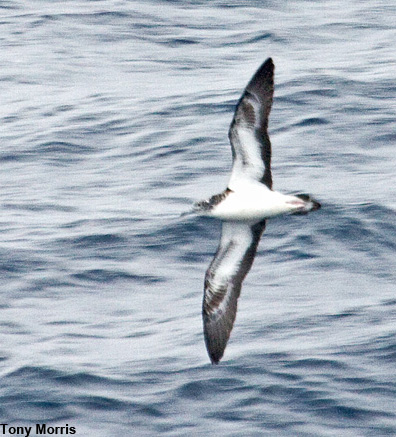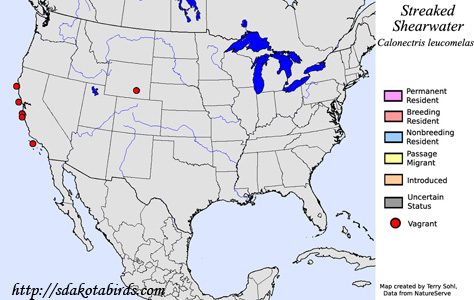Streaked Shearwater
Calonectris leucomelas
| Length: 18-20 inches | Wingspan: 48 inches | Seasonality: Non-resident in South Dakota |
| ID Keys: Pale brown above, white underparts and face, white underwings with dark flight feathers | ||
 The
Streaked Shearwater is a pelagic species found in eastern Asia southward to
Australia. It breeds on the coastline and nearby offshore islands of
southeastern Russia, Japan, Korea, and China. They are migratory and
move southward for the winter, wintering from southeastern Asia (Vietnam,
Phillipines, Indonesia) through the Australian region. They are but
rare vagrants to North America, with a handful of sightings off the
California and Oregon coasts, as well as Hawaii. Interestingly, in June of
2006, a carcass of a Streak Shearwater was found on the shores of a small
reservoir near Medicine Bow, Wyoming. They are not known to wander
inland, with a sighting of a bird at Red Bluff, California, representing the
only other inland sighting of the species in North America.
The
Streaked Shearwater is a pelagic species found in eastern Asia southward to
Australia. It breeds on the coastline and nearby offshore islands of
southeastern Russia, Japan, Korea, and China. They are migratory and
move southward for the winter, wintering from southeastern Asia (Vietnam,
Phillipines, Indonesia) through the Australian region. They are but
rare vagrants to North America, with a handful of sightings off the
California and Oregon coasts, as well as Hawaii. Interestingly, in June of
2006, a carcass of a Streak Shearwater was found on the shores of a small
reservoir near Medicine Bow, Wyoming. They are not known to wander
inland, with a sighting of a bird at Red Bluff, California, representing the
only other inland sighting of the species in North America.
Habitat: Found in both pelagic and inshore waters both during migration and during the summer breeding season. The greatest breeding concentration are on offshore islands of Japan, with a preference for those with forested slopes.
Diet: Feeds on fish and small squid
Behavior: Forages by flying over the water's surface and dipping down to grab prey in flight through surface skimming, or by making shallow plunges into the water in search of prey. Outside of the breeding season, they primarily feed during the day, where they often track schools of tuna and other predators that drive small fish prey near the surface.
Nesting: Streaked Shearwaters are colonial nesters, nesting on offshore islands or sometimes on protected shorelines in eastern Asia. The nest itself is a burrow, often constructed on a forested slope. A single egg is laid each breeding season, with both parents helping to incubate the egg and raise the young.
Song: Usually silent while in flight, but vocal in and around breeding colonies.
Migration: Migratory, with birds breeding on or near the shorelines of Japan, Russia, China, and Korea, and moving to southeastern Asia and Australia for the winter.
Interactive eBird map: Click here to access an interactive eBird map of Streaked Shearwater sightings
Similar Species: Most similar to Cory's Shearwater and Pink-footed Shearwater
Conservation Status: The Streaked Shearwater is listed as a "Near Threatened" species by the IUCN. The primary threats to the species are introduced rats, cats, and other species to their nesting islands, and birds being killed as bycatch from commercial fishing activities.
Further Information: 1) New Zealand Birds Online - Streaked Shearwater
2) WhatBird - Streaked Shearwater
3) Australian Department of the Environment - Streaked Shearwater
Photo Information: Photo licensed under Creative Commons Attribution NonCommercial 2.0 Generic License - Photo by Tony Morris
| Click below for a higher-resolution map |
 |
| South Dakota Status: Non-resident in South Dakota |
Additional Streaked Shearwater Photos (coming soon!!)
